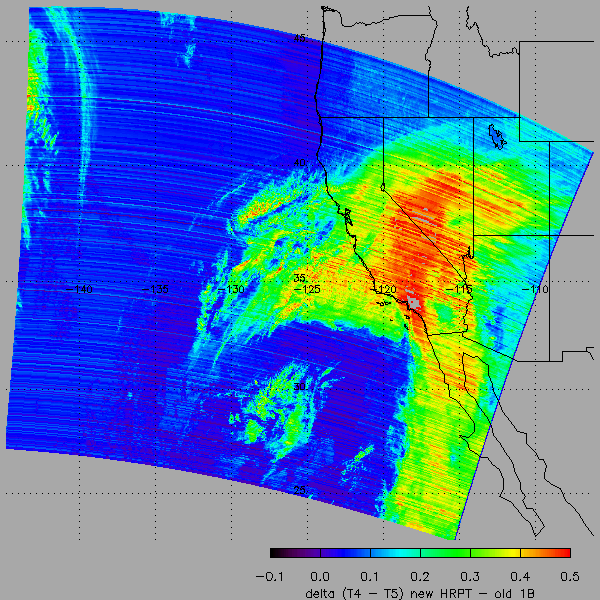 |
CIMSS-NOAA Weekly Report
[ Archive ] |
 |
ASPB AND CIMSS WEEKLY HIGHLIGHTS FOR THE WEEK ENDING FEBRUARY 14, 2003
IN THE PRESS:
ITEMS FOR THE ADMINISTRATOR:
ITEMS FOR THE ASSISTANT ADMINISTRATOR:
ITEMS FOR THE OFFICE DIRECTOR, ORA:
New Calibration
Technique Included in Experimental Clouds from AVHRR (CLAVR-x):
Recent analysis has shown the Advanced Very High Resolution Radiometer
(AVHRR) thermal calibration for cold pixels to be inadequate for some
cloud remote sensing techniques. This error is due to truncation of the
calibration coefficients in the NOAA-KLM level 1B data. A
calibration technique was implemented in CLAVR-x that uses the space
and blackbody information to derive thermal calibration coefficients
that are independent of the values contained in the level 1B data.
Another benefit to this approach is that it allows for a consistent
thermal calibration when reprocessing historic AVHRR data. (A. Heidinger, E/RA2,
608-263-6757, J. Sullivan, E/RA1, 301-763-8042)

(Click on image to enlarge)
Figure caption: The image above shows the error in the AVHRR channel
4 - channel 5 (11-12 micron) brightness temperature differences (BTD)
due to a truncation of calibration coefficients in the level 1B
data. The difference between the BTDs with the new and standard
calibration methods is shown.
Satellite-derived
Cloud Properties Improve Antarctic Climate Simulation: Cloud
properties from the extended AVHRR (Advanced Very High Resolution
Radiometer) Polar Pathfinder data set (APP-x) were incorporated into the
Arctic Region Climate System Model (ARCSyM) in order to improve the
simulation of the Antarctic surface energy budget. In the
experiments, the model cloud fields were altered via the water vapor
mixing ratio using APP-x cloud properties. Significant improvements in
monthly mean surface radiation fluxes were observed relative to surface
measurements. For example, in the austral summer the use of the
APP-x data set resulted in improvements in the downwelling longwave flux
as large as 30 W m-2 at the South Pole. A 10-year
surface energy budget data set will be made available to the public in
the near future. (J. Key,
E/RA2, 608-263-2605, M. Pavolonis, CIMSS)
ITEMS FOR THE DIVISION CHIEF, ARAD:
Paper on Arctic
Climate Trends Accepted for Publication: A paper titled "Recent
Arctic Climate Trends from Space: Clouds Regulate Surface Warming" was
accepted for publication in the journal Science. The paper is
co-authored by X. Wang (Cooperative Institute for Meteorological
Satellite Studies, CIMSS) and J. Key. It discusses trends in the
Arctic surface temperature, surface albedo, cloud amount, and cloud
forcing over an 18-year period based on data from the Advanced Very High
Resolution Radiometer (AVHRR), and how changes in cloud cover may be
damping the Arctic warming trend. (J. Key, E/RA2, 608-263-2605)
MODIS Science Team
Meeting: J. Key participated via telecon in the Moderate
Resolution Imaging Spectroradiometer (MODIS) Science Team meeting on
Wednesday, February 12. Topics included the upcoming data products
review meeting, the current NASA Research Announcement (NRA) for
research with Terra and Aqua satellite instruments, and budgets. (J. Key, E/RA2, 608-263-2605)
NASA Proposal
Reviews: J. Key reviewed two proposals for the NASA Research
Announcement for multidisciplinary research in climate, chemistry, and
global modeling. One proposal addressed the remote sensing of
Arctic clouds and their radiative effects; the other dealt with the
International Satellite Cloud Climatology Project (ISCCP) cloud product.
(J. Key, E/RA2,
608-263-2605)
Note: Participation in the AMS
Satellite Meteorology and Oceanography Conference will be reported next
week, as this report is being submitted before all participants have
returned.
VISITORS:
NEXT WEEK:
LOOKING AHEAD:
Archived Weeklies Page



